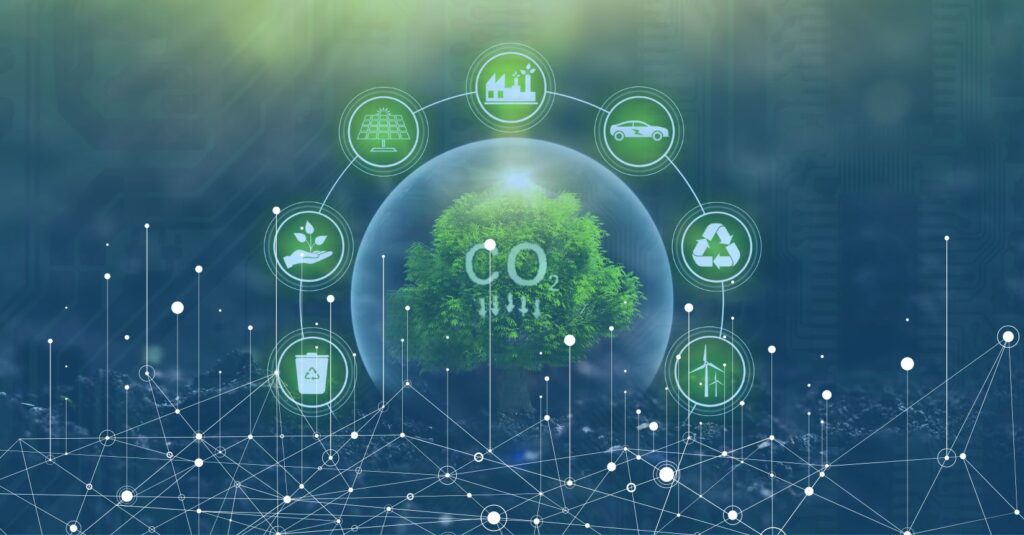Markets are rewarding decarbonization because decarbonization has benefits. The need for carbon data isn’t being driven by securities regulation, it is being driven by market rewards, consumer preferences, financial costs and incentives, reputational benefits, and a recognition that higher carbon emissions are a reflection of higher risk. Other government policies, from net-zero commitments to carbon taxes to incentives for decarbonization, are accelerating this reality.
Understand Your Carbon Footprint
The first step towards decarbonization is understanding your current carbon footprint. This involves a comprehensive audit of your operations to identify where emissions are being generated. Energy and sustainability data management software plays a crucial role here, enabling companies to track and analyze their energy use and greenhouse gas emissions accurately. By understanding your baseline, you can set realistic goals, prioritize actions, and measure progress over time.
Set Ambitious but Achievable Targets
Setting clear, ambitious, and achievable decarbonization targets is essential. These goals should be aligned with international standards, such as the Paris Agreement, to limit global warming. Consider adopting science-based targets (with SBTi) that specify how much and how quickly you need to reduce greenhouse gas emissions. This not only demonstrates a commitment to sustainability but also provides a clear roadmap for achieving these reductions.Committing to aggressive goals for enhancing energy efficiency and incorporating renewable energy sources is the best place to start.
Invest in Renewable Energy
Transitioning to renewable energy sources is one of the most effective ways to decarbonize. Solar, wind, hydro, and biomass can significantly reduce your dependence on fossil fuels, thereby lowering emissions. Investing in renewable energy can also offer financial savings in the long run, through reduced energy costs and potential government incentives. Installing photovoltaic (PV) systems can directly reduce reliance on fossil fuels by generating clean, renewable energy onsite. If onsite renewable generation is not feasible, purchasing green power from renewable sources through renewable energy certificates (RECs) or power purchase agreements (PPAs) is an alternative. Additionally, showcasing a commitment to renewable energy can enhance your company’s brand and appeal to eco-conscious consumers and investors.
Enhance Energy Efficiency
Improving energy efficiency is a cost-effective way to reduce emissions while also lowering operational costs. Conduct an energy efficiency audit to identify areas for improvement, such as upgrading to energy-efficient lighting and equipment, optimizing heating and cooling systems, and enhancing building insulation. Investing in the latest HVAC (Heating, Ventilation, and Air Conditioning) systems can reduce energy consumption and emissions. Look for systems with high SEER (Seasonal Energy Efficiency Ratio) ratings. In addition, replacing traditional lighting with LED alternatives can reduce lighting energy use by up to 75%. Implementing these measures can lead to substantial energy savings and reduced carbon emissions.
Leverage Carbon Offsetting
While reducing emissions at the source is preferable, carbon offsetting and carbon capture technologies offer additional pathways to achieve net-zero emissions. Carbon offset projects, such as reforestation or investments in renewable energy, can compensate for the emissions you cannot eliminate.
Enhancing Supply Chain Sustainability:
Companies will increasingly address their value chain emissions (Scope 3 emissions), which for many sectors constitute the majority of their carbon footprint. Strategies will likely include enhanced supplier engagement, product life cycle assessments, and circular economy practices. Companies can make significant emissions reductions by optimizing logistics, investing in sustainable materials, and only collaborating with suppliers who prioritize carbon footprint reduction. Firms can use their influence to encourage and support value chain partners to set credible emissions reduction targets, reinforce expectations through solicitation and contracting language, and engage in advocacy and lobbying to help create the conditions for your value chain partners to be successful. Consider providing training to help suppliers increase their carbon literacy, set credible targets, gather and report emissions data, and learn about and evaluate the suitability of programs, technology, and opportunities to reduce their carbon footprint. In addition to training, technical support for decarbonization can be a way to provide more targeted and specialized assistance to enhance the capacity and capabilities of suppliers.
When it comes to procurement, embedding emissions criteria into sourcing processes can allow for the identification of cost increases related to decarbonization. In doing so, retailers can ensure that negotiations with suppliers are grounded in the realities of transitioning to greener materials and processes.
More About WatchWire
WatchWire by Tango is a market-leading, energy and sustainability data management platform that uses cloud-based software to collect, automize, and analyze utility, energy, and sustainability data metrics. WatchWire streamlines, automates, and standardizes your sustainability reporting process by integrating directly and/or providing reporting exports to ENERGY STAR Portfolio Manager, LEED Arc, GRESB, CDP, SASB, GRI, and more. The platform provides customizable dashboards, which allow asset managers, sustainability managers, engineers, and more to monitor individual key performance indicators (KPIs) and create custom views for specific use cases.
To learn more about WatchWire and its capabilities, you can visit our website, blog, or resource library, request a demo, or follow us on LinkedIn, Instagram, or Twitter to keep up-to-date on the latest energy and sustainability insights, news, and resources.
 Top Sustainability Trends to Watch in 2025
Top Sustainability Trends to Watch in 2025

 Log In
Log In









